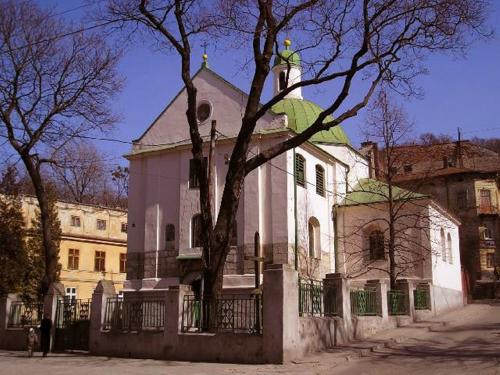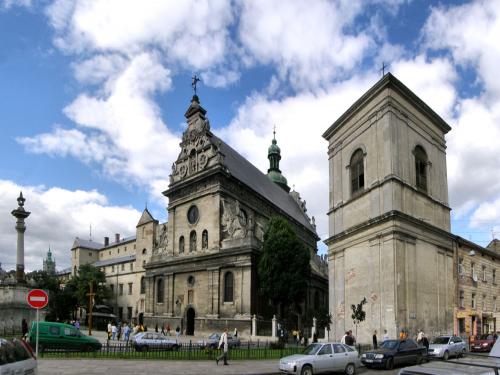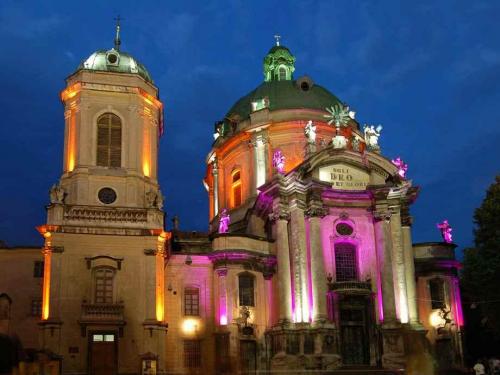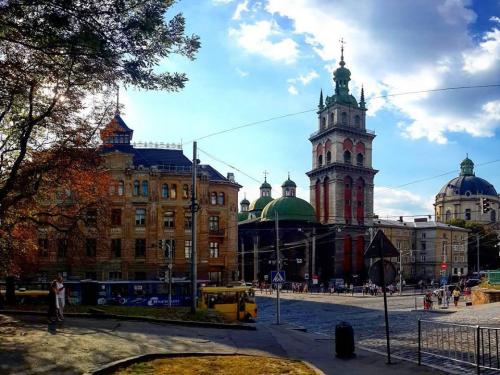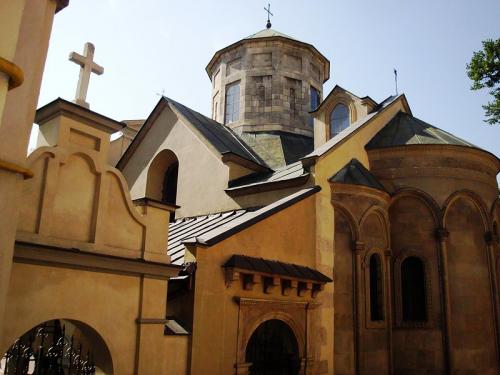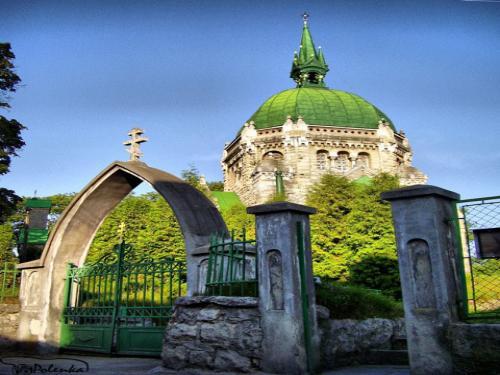Lviv
Lviv is the heart of Galicia and Western Ukraine.
You should begin your journey around Lviv by walking through the streets of the Old City and visiting High Castle Hill – the highest spot of the city that gives an opportunity to see a great panorama of Lviv with its state-of-art architecture, that reflects almost all the trends of European art of the 13-20th centuries. We invite you to stroll along the alley of the quiet Stryisky Park and see Boims Chapel, which is truly unique in Eastern Europe as far as its architecture and fretwork are concerned. Drop by the Italian Courtyard and walk within the vivid Armenian and Jewish quarters. Lviv also called as “The Lion City” became a house of many religions. Today some of the city’s street names – for example Virmenska (Armenian) , Yevreyska (Jewish) and Serbska (Serbian) – still remind visitors that once ethnic communities of Ukrainians and Greeks, Germans and Serbs, Jews, Italians and Poles, Scots, Tatars, Hungarians and Saracens combined to create a Babylon of the medieval town of Lviv. Don’t miss Rynok Square located at the very heart of the city. The Square together with the City Hall make one of the best architectural ensembles in the city. The narrow cobbled streets around Rynok Square once housed the workshops of Lviv printers, chemists and numerous Lviv tradesmen. Cozy cafes, where Lviv’s literary and artistic Bohemia liked getting together, create particularly fascinating atmosphere in the Old City. Black coffee is an integral part of living Lviv-style. It is said that it was Prince Yuri Kulchytsky – one of prominent figures in Ukrainian and European history – to introduce this tradition in Lviv. He was the one to offer Europeans the then-unknown aromatic beverage back in 1678 by founding a coffee-shop café in Vienna – the first café of such type Europe.
There is a café in Lviv that carries the name of Yuri Kulchytsky. After visiting Lviv coffee-cafes you will see that the true art of coffee-cooking thrives in the city.
St. George’s Cathedral
A masterpiece of Ukrainian baroque, the cathedral was built on the site of a 14th century temple by the efforts of the Lviv Metropolitan, Andiy Sheptytsky. St. George’s Cathedral is considered to be a symbol of unity of two branches of Christianity – Orthodox and Catholic – since western Ukraine is the motherland of the Greek Catholic Church founded in the 16th century. The most precious relic of the church is a miraculous icon of the St Mary, The Mother of Christ (17th century). The front of the cathedral is decorated with figures of saints, made by Johan Pinsel, a prominent Lviv sculptor. He is well-known in Europe as the inventor of the original sculpting technique and is thus called Lviv’s Michelangelo.
Latin Metropolitan Cathedral (1360-1480)
This cathedral’s forms are strict and majestic, reflecting a harmonious combination of Gothic and Baroque styles. Polish King Kazimierz the Great laid the corner stone of this Roman Catholic church. At the end of the 19th century , a stained-glass window that completed the interior of the cathedral was made according to the design of Ya. Mateiko, Yu. Mehoffer and T. Aksentovych. It now hosts the Lviv Cathedral of the Latin rite.
St. Nicolas Church (1264 – 1340 )
The church was built as a burial vault for Galicia princes and is one of the oldest architectural monuments of the city.
Bernardian monastery complex
The complex comprises of the Bernardian St Andrew’s Roman Catholic Church (1600-1630) , monastery buildings, belfries, a rotunda over a well surrounded by a defensive wall, and a decorative column. Here everything makes visitors envisage the life-style of medieval monks from Bernardian Order who always took cake of travelers, giving them refuge, food and warmth.
Dominican monastery
The Dominican Roman Catholic Church, designed by architect lan de Vitte, is a majestic Baroque construction, with its wonderful interior, decorated with 18 unique carved wooden figures of saints of the Dominican Order. The ensemble consists of a monastery (16-17th centuries) and a belfry. Today it contains a museum of the history of religions. There is also an art and cultural center, Dzyga which includes a gallery of modern art, an acoustic concert hall, a saloon-shop and a recording studio. If you are lucky, you can become one of the participants of a creative event of this Art Center featuring Ukrainian artists.
Uspenska (Assumption) Church complex
The complex combines the Assumption Church of the Blessed Virgin (1591-1629), Kornyakta Tower, which is amongst the most beautiful buildings in Europe, and the Chapel of Three Baptists, which contains examples of artworks of Lviv Renaissance architecture skillfully combined with local building traditions.
Armenian Cathedral (1360-1370)
The Armenians that settled in Lviv in the 13th century founded a cathedral for it to unite national Armenian and local architectural traditions. Opposite the cathedral stands a column of the figure of St. Christopher with the Armenian archbishop’s palace next to it.
Lviv Opera House
The Lviv Opera and Ballet House, a state-of-art architectural creation, is among the most famous and beautiful places in Europe. The theater was built by famous Vienna architect Z. Gorgolevsky in the “Vienna pseudo-Renaissance” style , which is a mixture of different architectures. The theater celebrated its centennial recently. From that time it has carried the name of famous Ukrainian singer, Solomiya Krushelnytska. Her charming voice was heard on every famous world stage together with the great singers of the 20th century, such as Caruso, Batistini, Shalyapin, and the conductor Toscanini. It was for Krushelnytska that Jacomo Puccini composed the opera “Cio-Cio-San”.
Now there are 25 operas, 15 ballet performances and 2 operettas in the theater’s repertoire. Performances are in Ukrainian, Russian, Italian and Polish.
The National Museum in Lviv
The Museum was founded in 1905 by Metropolitan Andriy Sheptytsky, an outstanding figure in Ukrainian history. Not only was Sheptytsky one of the outstanding ecumenists of the world who sought the unification of the Christian churches, but also a great patron of Ukrainian art and book-printing. In the Museum you will see a unique collection of Ukrainian icon paintings from the period of 14-17th centuries. Old manuscripts, sculptures, paintings, etchings and folk arts will attract your attention.
The Lviv Historical Museum
This is one of the oldest museums in Ukraine. It contains a great exposition from the Old World and Middle Ages. The museum presents a new approach towards history of Kyiv Rus and Galicia-Volyn principality. Some parts of the expositions of the museum belong to the World Heritage: a hand-written Khrystynopilsky Apostle (12th century), the Order of Andriy Pervozvanny and materials reflecting the life of Chopen.
Arsenal Museum
This is the only museum of weapons in Ukraine. The collection of “Winged Hussars” (16th century) is one of the richest in Europe. Arsenal exhibits a great collection of old steel weapons, firearms and cannons made in famous workshops in 32 countries of the world.
Lychakivsky Cemetery
The cemetery is a historic burial complex with every tomb’ decoration being a piece of art created by architects and sculptures from the previous centuries. The cemetery is a museum of memorial arts and a pantheon of the Ukrainian, Polish and Austrian cultures. Outstanding men of the arts and sciences, composers and participants of military actions in the 20th century are buried here.
The Pharmacy Museum
The museum is located in a building of the first pharmacy in Lviv , that appeared here over 250 years ago. You will get to know the history of pharmaceutics, which was always one of the leading spheres in the economy of Galicia and held a leading position in the world for centuries. Here you can peep into the most secrete corners of old mazes and visit the study of a medieval alchemist.
Lviv Art Gallery
This is the biggest art museum in Ukraine, with a collection of more than 53 thousand artworks from the period of 14-20th centuries. Among the most precious ones are collections of European Art, Lviv sculptures and portraits, as well as icons. Among the exhibits are works of mysterious Lviv sculptor Johan Pinzel, who became a European sensation at the beginning of the 20th century. There are rare works of Polish and Austrian artists in the gallery. But the jewels of the permanent exposition of Lviv Art Gallery are the artworks by world renowned masters, such as Rrubens, de la Turet, Goya, A. Mengs, Ya. Mateiko. Lviv Art Gallery also acts as a big scientific and educational center, which hosts conferences and internships for art experts and restorers. For many years already, the Gallery has taken part in organizing international exhibitions in Ukraine, Poland, the USA, France and Austria.


